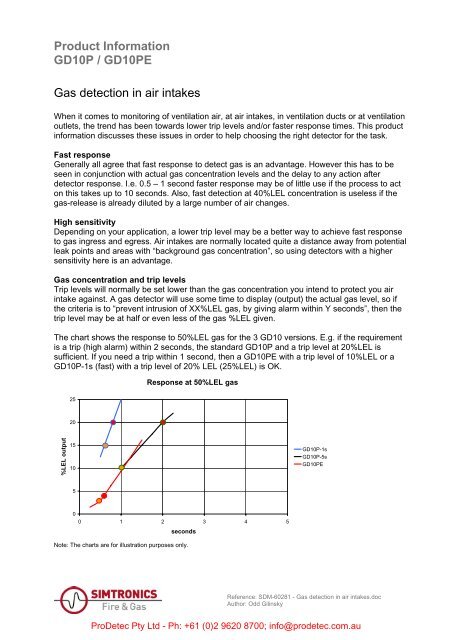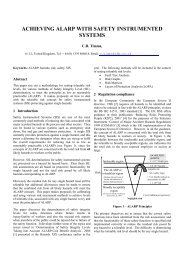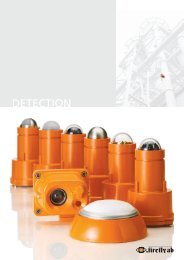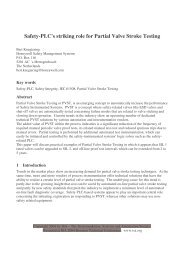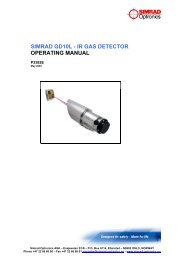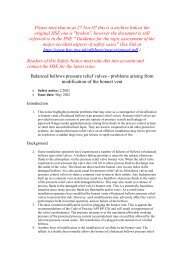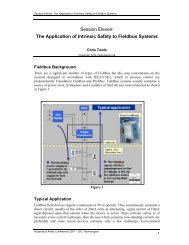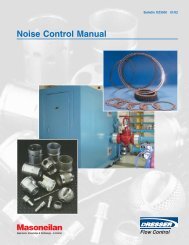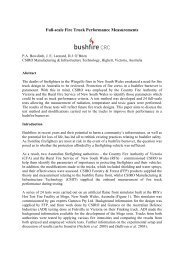Gas Detection in Air Intakes - ICEWeb
Gas Detection in Air Intakes - ICEWeb
Gas Detection in Air Intakes - ICEWeb
Create successful ePaper yourself
Turn your PDF publications into a flip-book with our unique Google optimized e-Paper software.
Product InformationGD10P / GD10PE<strong>Gas</strong> detection <strong>in</strong> air <strong>in</strong>takesWhen it comes to monitor<strong>in</strong>g of ventilation air, at air <strong>in</strong>takes, <strong>in</strong> ventilation ducts or at ventilationoutlets, the trend has been towards lower trip levels and/or faster response times. This product<strong>in</strong>formation discusses these issues <strong>in</strong> order to help choos<strong>in</strong>g the right detector for the task.Fast responseGenerally all agree that fast response to detect gas is an advantage. However this has to beseen <strong>in</strong> conjunction with actual gas concentration levels and the delay to any action afterdetector response. I.e. 0.5 – 1 second faster response may be of little use if the process to acton this takes up to 10 seconds. Also, fast detection at 40%LEL concentration is useless if thegas-release is already diluted by a large number of air changes.High sensitivityDepend<strong>in</strong>g on your application, a lower trip level may be a better way to achieve fast responseto gas <strong>in</strong>gress and egress. <strong>Air</strong> <strong>in</strong>takes are normally located quite a distance away from potentialleak po<strong>in</strong>ts and areas with “background gas concentration”, so us<strong>in</strong>g detectors with a highersensitivity here is an advantage.<strong>Gas</strong> concentration and trip levelsTrip levels will normally be set lower than the gas concentration you <strong>in</strong>tend to protect you air<strong>in</strong>take aga<strong>in</strong>st. A gas detector will use some time to display (output) the actual gas level, so ifthe criteria is to “prevent <strong>in</strong>trusion of XX%LEL gas, by giv<strong>in</strong>g alarm with<strong>in</strong> Y seconds”, then thetrip level may be at half or even less of the gas %LEL given.The chart shows the response to 50%LEL gas for the 3 GD10 versions. E.g. if the requirementis a trip (high alarm) with<strong>in</strong> 2 seconds, the standard GD10P and a trip level at 20%LEL issufficient. If you need a trip with<strong>in</strong> 1 second, then a GD10PE with a trip level of 10%LEL or aGD10P-1s (fast) with a trip level of 20% LEL (25%LEL) is OK.Response at 50%LEL gas2520%LEL output1510GD10P-1sGD10P-5sGD10PE500 1 2 3 4 5secondsNote: The charts are for illustration purposes only.Reference: SDM-60281 - <strong>Gas</strong> detection <strong>in</strong> air <strong>in</strong>takes.docAuthor: Odd Gil<strong>in</strong>skyProDetec Pty Ltd - Ph: +61 (0)2 9620 8700; <strong>in</strong>fo@prodetec.com.au
Product InformationGD10P / GD10PEThe picture is slightly different <strong>in</strong> the case we would like to have the same response criteria for agas concentration of 25%LEL. For a trip response with<strong>in</strong> 2 seconds, the GD10PE at 10%LEL orthe GD10P-1s (fast) at 20%LEL is required. A response with<strong>in</strong> 1 second is possible with theGD10PE at 5%LEL only.2520Response at 25%LEL gasM<strong>in</strong>imumlevelsWarnTripGD10P-1s 15%LEL 20%LELGD10P-5s 10%LEL 20%LELGD10PE 3%LEL 4%LEL%LEL output1510GD10P-1sGD10P-5sGD10PE500 1 2 3 4 5secondsFor air <strong>in</strong>takes and for gas turb<strong>in</strong>e ventilation we may be concerned about gas concentration ofeven lower levels, here the GD10PE is the best option.Warn<strong>in</strong>g- and Trip-levelsWe recommend that a safety marg<strong>in</strong> of 100% (I.e. 2x) of the nom<strong>in</strong>al long term stabilitytolerance is used as the lowest level for a “warn<strong>in</strong>g” or “low alarm”. A warn<strong>in</strong>g should not <strong>in</strong>itiateany automatic shutdown action. For high alarm or trip, a m<strong>in</strong>imum level of 20% of full scale ofthe detector is recommended.It is also good practice to have a certa<strong>in</strong> distance between low and high alarm levels, and afactor of 2x has been the typical <strong>in</strong>dustry standard. With the trend of reduc<strong>in</strong>g alarm levels, thismarg<strong>in</strong> between warn<strong>in</strong>g and shutdown has been reduced <strong>in</strong> several projects.Choos<strong>in</strong>g the right GD10 for the taskGD10P- standard (“5 sec”)This detector should be the default choice as a general po<strong>in</strong>t detector. Depend<strong>in</strong>g on yourrequirements it is also suitable for air <strong>in</strong>takes and duct mount<strong>in</strong>g. Warn<strong>in</strong>g and trip levels can bedown to 10%LEL and 20% LEL respectively (2x marg<strong>in</strong>).GD10P – fast (“1 sec”)This detector is designed for fast response, and is very fast at trip levels (high alarm) of 20%LELand above. Please note that at a trip level of 20%, the m<strong>in</strong>imum warn<strong>in</strong>g level of 15% is quiteclose.GD10PEThis detector is 5 times as sensitive as standard po<strong>in</strong>t detectors, its scale cover<strong>in</strong>g 0 – 20%LEL.At gas concentrations above scale, it will ma<strong>in</strong>ta<strong>in</strong> an output of 20%LEL. GD10PE is designedfor fast detection of low gas concentrations. For detection of gas concentrations of less than20%LEL, i.e. when you need trip levels (high alarm) of 5 -15%LEL, the GD10PE is the bestsolution available.Page 2ProDetec Pty Ltd - Ph: +61 (0)2 9620 8700; <strong>in</strong>fo@prodetec.com.au


